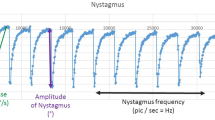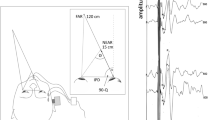Abstract
Human subjects placed in strong magnetic fields such as in an MRI scanner often feel dizzy or vertiginous. Recent studies in humans and animals have shown that these effects arise from stimulation of the labyrinth and are accompanied by nystagmus. Here, we measured the three-dimensional pattern of nystagmus using video eye tracking in five normal human subjects placed in a 7T MRI to infer which semicircular canals are activated by magnetic vestibular stimulation. We found that the nystagmus usually had a torsional as well as a horizontal component. Analysis of the relative velocities of the three eye movement components revealed that the lateral and anterior (superior) canals are the only canals activated, and by a similar amount.



Similar content being viewed by others
References
Antunes A, Glover PM, Li Y, Mian OS, Day BL (2012) Magnetic field effects on the vestibular system: calculation of the pressure on the cupula due to ionic current-induced Lorentz force. Phys Med Biol 57:4477–4487
Glover PM, Cavin I, Qian W, Bowtell R, Gowland PA (2007) Magnetic-field-induced vertigo: a theoretical and experimental investigation. Bioelectromagnetics 28:349–361
Grunfeld EA, Okada T, Bronstein AM et al (2000) The effect of habituation and plane of rotation on vestibular perceptual responses. J Vestib Res 10:193–200
Jareonsettasin P, Otero-Millan J, Ward BK, Roberts DC, Schubert MC, Zee DS (2016) Multiple time courses of vestibular set-point adaptation revealed by sustained magnetic field stimulation of the labyrinth. Curr Biol 26:1359–1366
Leigh R, Zee D (2015) The neurology of eye movements, 5th edn. Oxford University Press, New York
Mian OS, Li Y, Antunes A, Glover PM, Day BL (2013) On the vertigo due to static magnetic fields. Available at http://dx.plos.org/10.1371/journal.pone.0078748. Accessed 17 Feb 2017
Otero-Millan J, Roberts DC, Lasker A, Zee DS, Kheradmand A (2015) Knowing what the brain is seeing in three dimensions: a novel, noninvasive, sensitive, accurate, and low-noise technique for measuring ocular torsion. J Vis 15:11
Roberts DC, Marcelli V, Gillen JS, Carey JP, Della Santina CC, Zee DS (2011) MRI magnetic field stimulates rotational sensors of the brain. Curr Biol 21:1635–1640
Robinson DA (1982) The use of matrices in analyzing the three-dimensional behavior of the vestibulo-ocular reflex. Biol Cybern 46:53–66
Tweed D, Sievering D, Misslisch H, Fetter M, Zee D, Koenig E (1994) Rotational kinematics of the human vestibuloocular reflex. J Neurophysiol 72:2467–2479
Ward BK, Roberts DC, Della Santina CC, Carey JP, Zee DS (2014) Magnetic vestibular stimulation in subjects with unilateral labyrinthine disorders. Front Neurol 5 Available at: http://www.ncbi.nlm.nih.gov/pmc/articles/PMC3952138/. Accessed 17 Feb 2017
Ward BK, Roberts DC, Della Santina CC, Carey JP, Zee DS (2015) Vestibular stimulation by magnetic fields. Ann NY Acad Sci 1343(1):69–79
Acknowledgements
This study was funded by the Fight for Sight and Leon Levy Foundations, the Johns Hopkins School of Medicine Discovery Fund, and the Cinquegrana, Lott, and Schwerin families.
Author information
Authors and Affiliations
Corresponding author
Ethics declarations
Conflicts of interest
On behalf of all authors, the corresponding author states that there is no conflict of interest.
Ethical standards
This study has been approved by the institutional review board at the Johns Hopkins University School of Medicine and has been performed in accordance with the ethical standards established in the 1964 Declaration of Helsinki.
Additional information
This manuscript is part of a supplement sponsored by the German Federal Ministry of Education and Research within the funding initiative for integrated research and treatment centers.
Rights and permissions
About this article
Cite this article
Otero-Millan, J., Zee, D.S., Schubert, M.C. et al. Three-dimensional eye movement recordings during magnetic vestibular stimulation. J Neurol 264 (Suppl 1), 7–12 (2017). https://doi.org/10.1007/s00415-017-8420-4
Received:
Accepted:
Published:
Issue Date:
DOI: https://doi.org/10.1007/s00415-017-8420-4




